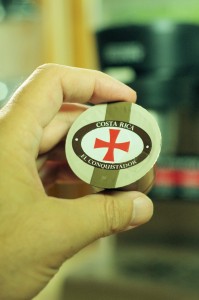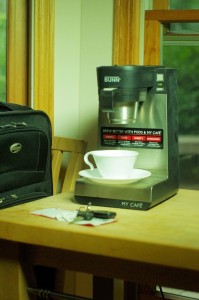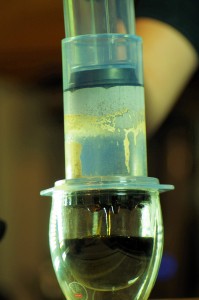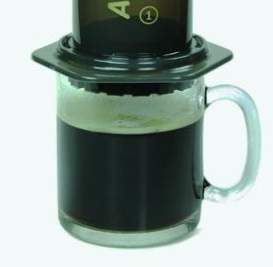by Coffee Kevin | Apr 24, 2015 |
 I keep saying we’re living in a golden age of coffee brewing. This year’s Seattle SCAA Event brought more brewers. There are even a few coffee discoveries to report. Here are some highlights:
I keep saying we’re living in a golden age of coffee brewing. This year’s Seattle SCAA Event brought more brewers. There are even a few coffee discoveries to report. Here are some highlights:
Nick Kohout of Arcaia showed me some scales that, frankly, did not impress me at first. I mean, they supposedly have some higher-end parts than comparable Bonavita scales, but does that excite anyone? I’ve had no problems with any Bonavita scales, not that I’m a barista, but I’m just being honest. Then he showed me how its timer keeps track of the contact time in manual brewing. Apparently, it detects when the water has gone through the grounds, and pauses the clock. Now I am excited! Their goal of connecting folks via the web so they can meaningfully compare their brews is also a step in the right direction.
Lots of new coffeemakers, some Kickstarter projects and others already developed and seeking coffee stores to recommend and sell them to customers. Gregory Bombeck’s Phoenix coffeemaker was one. Another was the Kinto coffeemaker from Japan. Saint Anthony Industries has one of the most beautiful cold brew makers I’ve yet seen, although the whole cold brew thing leaves me… oh, I won’t say it.
My own personal favorite was from 21 year-old Cameron Hughes of Invergo Coffee, of Garden City, New York. His brewer’s patented swiveling spray head may have cracked a problem that’s plagued automatic drip makers since George Bunn introduced the first Bunn-O-Matic in the 1950s, and that is how to effectively mimic the way you and I pour water so beautifully by hand. He also claims you can set the brewing temperature, not revolutionary, but makes me want to test his machine in my kitchen. My at-show tasting was compelling however. Remember, Orson Welles was twenty one when he became famous in radio. Post-moderns may prefer a Beatles analogy.
At the Remarkable Indonesia pavilion, they were tasting some interesting coffees. It’s no secret that I’m a fan of this country’s coffees. The flavor diversity is astounding, and I can only assume that it’s distance and the fact the only a select few green buyers (think Geoff Watts) ever makes the trek (20 hours-plus) to actually visit. My personal taste favorite was Bali coffee. I admit I have a guilty pleasure for some of their robusta varieties as well. But the news this year was their showing clips of a new film, Aroma of Heaven, created, written and lensed by cinematographer Budi Kurniawan. Budi K, as he introduced himself, is almost as interesting as his film. A compulsive shooter, he had a camera in his hand both times I’ve seen him. I predict this film will be a big hit among coffee enthusiasts. It deserves special mention for being the first film to not seem like a colonialist perspective, but rather an honest, if not bitter, but also not candy glossed look at coffee. Indonesia goes pretty far back in coffee history, by the way. Budi says a download is going to be available, but I’m pitching for some neighborhood showings (I know someone at CoffeeCon hehe). It’s a remarkable film, and thanks to a screening of it in entirety) I speak with confidence.
I’ve been trying to track down Breville products for reviews for years. Fortunately, a changing of the guard has opened transparency and Category Manager Alejandra Lin has pledged to get us some of their products that are promising. I’ve heard good things about their grinders, but talk (especially about grinders) is cheap. Let’s get one and do some measurements, which is what matters. Breville really had something that caught my attention. Alejandra told me their automatic drip maker has the ability to modify its contact time according to volume. As you may know, most automatic drip makers’ contact time between the grounds and hot water is optimized for one specific cup size, usually, but not always, the maximum. Make more coffee, it’s too strong/bitter. Make less, it’s weak/undeveloped. If the new Breville machine delivers, it will be front page news (here anyway!).
The show surprise was this new stovetop coffee roaster. Jung Park of Dr Mahn Coffee brought his new design from Korea, which seems to be experiencing a coffee renaissance of new innovations. Can’t wait to try it, remembering both the 1990s Palani Pan roaster and the importance of a kitchen fan when roasting over fire. What this country needs is a simple professional quality sample roaster on par with the classic Siemans Sirocco coffee roaster long out of production (spotted one last week on eBay, which was snapped up before I could say “Buy it Now”. I think I may have found it. Luke Kawa of Kawa Coffee had one, which is also extremely attractive, but how it roasts will be what interests me most, of course.
Remember a Netherlands company named Bravilor? They used to be distributed by Boyds. I always thought of them as a commercial version of Technivorm. They are about to introduce a consumer automatic drip coffeemaker. Seemed very robust, but not coffee samples at SCAA. Might be ready by CoffeeCon Chicago in July, according to Eric Covelli, Bravilor Marketing
VP. Had a delightful dinner with Kenneth Davids, famous author of many books on our favorite subject. One of our topics was the current Geisha coffee craze. According to Professor Davids, there are genuine attributes to the Geisha cultivar. One such sample (roasted here in Chicago by Big Shoulders) earned a whopping 96 rating in a recent CoffeeReview.com tasting.
Bonavita had their latest 5-cup maker and many other products on display. They’re an amazing coffee maker success story. I’m particularly interested in this size category because as more people buy specialty (read: expensive) beans, they’re going to take a closer look at over-brewing those twelve cups, when they each have a couple (read: 4). Marcus Boni assured me a sample will be sent and, of course, a review will result.
Jim Shanley is a farmer with a unique geographic location. He’s in California and his farm is aptly titled, California Coffee Farms, the first I know of in the continental 48 states. Hopefully I will try some soon.
Robin Thorum spoke to one of my favorite subjects, testing grinders. Mr Thorum’s company has done a lot of research on measuring irregular objects such as coffee grounds. According to him, laser measuring tools presume all ground particles to be spherical, which would be nice, but anyone can see this is not so. Ditto traditional sieve tests, where oblong grind particles outsmart screens and slither through, which gives inaccurate comparisons. What we want to measure of course is surface area. He claims his company, Coffee Laboratory, has developed a better, more accurate way to measure this surface area.
At the expense of getting a little sniffly, there were several awards given to longstanding coffee industry members that deserve mention here. First, Carlo Di Riocco, whose Mr Espresso is the curator of what many of us consider the true Italian espresso. Di Riocco started as an engineer, but combined his insistence on consistency with art. I compel anyone to find a finer drink. He’s also kept doing the right thing against various fads in espresso roast, preparation and serving, a combination that’s kept his product unique.
Oliver Strand was able to do what no other comparable media personality has, and that’s bring coffee to the pages of a big city newspaper, in this case the New York Times. The coffee people I know don’t always agree with him, but that fact is they read everything he writes. So do mainstream readers and that’s what’s most important. If coffee is really the next wine it needs to enter culinary arts columns nationwide. The best part to me is he is real. He really is a coffee enthusiast, not a poseur. I still cringe when I view how coffee has been presented on the Food Network.
Finally, La Minita’s Bill McAlpin was the first person I called after I read a Corby Kummer Atlantic article about coffee. After hearing my own enthusiasm for coffee and wanting to learn and write about it, spent an hour or more discussing it with me, and even introduced me to Ken Stevenson and others so I could get a proper education. I’ve met no more generous person than him in the years I’ve been a coffee scribe. The fact that La Minita defined what is now called a specialty coffee farm is possibly of equal importance. Oh yes, and the coffee is always great! Bill McAlpin was finally properly honored this year. I was surprised to see the outwardly cooler McAlpin get glossy-eyed while receiving his award. Mr Espresso seemed to foster a trend, making these normally staid awards a three-hanky one. Even I wasn’t immune from tearing up a bit seeing these greats get their just acknowledgement.
Finally, we surprised to see OXO, seemingly moments after the Chicago International Housewares Show. Claire Ashley and her team brought their new coffeemakers and accompanying grinder, which features a built-in scale. Lots of folks whispering about it, as I think it shocks them to think a large housewares company (admittedly mostly unpowered) might enter the coffeemaker sweepstakes. I keep telling folks, brewers are the power behind the glory in every great cup of coffee. Great job, SCAA. Another fun and productive trade event.
by Coffee Kevin | Sep 9, 2014 |
 Recently, I reviewed every brewing format in the U.S. I freely admit I was previously strongly biased against pods in general and specifically the K-Cup, the number one pod format. My reasons weren’t simple connoisseur snobbery, but cool analysis based upon the following industry givens:
Recently, I reviewed every brewing format in the U.S. I freely admit I was previously strongly biased against pods in general and specifically the K-Cup, the number one pod format. My reasons weren’t simple connoisseur snobbery, but cool analysis based upon the following industry givens:
- Coffee must be brewed within two weeks from roasting.
- Drip coffee must be brewed over four-to-six minutes.
- Small batch, top-end roasted coffee isn’t available in K-cups.
Oh, and don’t forget this one:
- Anything too popular has to be bad.
With me so far? Good. Now, a few things happened since then to open my mind to at least the possibility that K-Cups might be a viable format. First, there is the Bunn My Café machine. In my tests this one machine was heads above the others in its ability to extract coffee. Keep in mind that for years Bunn has specialized in three-minute extraction through its almost-power-washing sprayhead design in traditional drip machines. The My Café gets the water up to industry-standard temperature heights and somehow (I’m not yet able to see into the brewing chamber) this results in a much better-than-average cup.
Second, the K-Cup patent expired. This means machinery entrepreneurs will be exploiting the format, perhaps even beyond what Bunn’s done (Bunn’s was developed through licensing prior to the expiration). The patent’s lapse also means a wider variety of coffee brands will be free to flood the market with K-Cups.
Third, new smaller-run K-Cup packaging machines have emerged to make it cost-effective for local roasters to make their own K-Cups. This has caused a virtual explosion. While some specialty roasters are still keeping their distance, several have announced top quality coffees in K-Cups to the general public. This brings us the likelihood of neighborhood, fresh coffee.
Last but not least, there are new in-cup technologies. In some ways these are the hardest to understand, much less describe. Boyd Coffee introduced a new K-Cup of their own design at the 2014 SCAA Conference. Even with all the coffee samples I’d had that day, the Boyd’s design was night and day better than I’d previously tasted. Boyd’s has a new type of bottom to its pod that is closer to a traditional filter. While it seems like it would undermine the already-short contact time between hot water and ground coffee, it clearly resulted in a more thorough extraction.

This travel photo shows why this pods are important to good coffee.
I finally tasted close to coffee nirvana later at that same event when I had a La Minita K-Cup. This design, as explained by CEO Bill McAlpin, utilizes material obtained from the surgical profession that is both slow to release but allows greater transfer of flavor oils, thus coming closest yet to what the industry calls “Gold Cup” standards.
I realize McAlpin’s coffees are already pinnacle specialty coffees that score in the 90s among coffee reviewers, but this cup truly floored me. McAlpin, more than anyone else I’ve met, convinced me he truly understands the entire process. His K-Cup’s design takes full advantage of every second of contact time inside the K-Cup (something under one minute!) and then that special material at the K-Cup’s bottom makes sure the coffee essence exits the cup in its full glory and into your cup.
McAlpin claims he’s done blind tests among the top roasters and they are unable to distinguish between their roasts brewed using a traditional drip brewer versus the same coffee prepackaged in his K-Cups! I can only underscore that I believe this might be possible using this technology and a top quality K-Cup brewer!!!
I’m sure that some jaws will drop after reading this last paragraph and my having written it. My position is I try very hard to be a coffee objectivist in what surely must be understood to be a largely subjectivist world.
I am certainly not urging anyone to discard their Chemex, Hario or French press makers for K-Cups, nor for that matter their Technivorm, Bonavita or Behmor traditional automatic drip machines. What I am suggesting is to consider what this offers in terms of consumer choices and the possibility of getting a good-to-near-great cup of coffee fully automatically and conveniently. Even I must have an option for those times in my life where the process is not the goal, but a necessity of my real goal: getting a savory cup of coffee. Such times are quick morning starts, mornings when I am heading to an airport for an early flight. Sometimes a friend drops by and we want to share the coffee, but not the time it takes to make it the manual multiple step way.
Let’s remain open minded. Let’s also retain a healthy dose of skepticism. I am simply declaring that it’s now been proven to me that it IS possible to get a very good cup of coffee with a pod machine. Once it is POSSIBLE, it’s just a question of determining how it was done, then doing it that way. Remember, The Coffee Companion’s mission is great coffee, not labor, nor for that matter technology. Stay tuned!
by Coffee Kevin | Jul 8, 2014 |
 The Aeropress marks the longest I’ve ever waited for formally review a product. I met inventor Alan Adler nine or more years ago. We were introduced by then Bunn VP Aimee Markelz. Just to show how gracious some people can be even in an industry with such hot competition as coffeemakers, Ms Markelz was walking through the International Housewares show before showtime and spied this new coffeemaker. When I did my usual walkaround at Housewares she handed me a slip of paper with the Aeropress booth number on it. She told me she thought I’d find it interesting. I did. I do.
The Aeropress marks the longest I’ve ever waited for formally review a product. I met inventor Alan Adler nine or more years ago. We were introduced by then Bunn VP Aimee Markelz. Just to show how gracious some people can be even in an industry with such hot competition as coffeemakers, Ms Markelz was walking through the International Housewares show before showtime and spied this new coffeemaker. When I did my usual walkaround at Housewares she handed me a slip of paper with the Aeropress booth number on it. She told me she thought I’d find it interesting. I did. I do.
The reason I waited so long to review it? I guess I took it for granted. But now I feel a little guilty and negligent. Or it’s such an open-ended device it all depends on how you use it. Honestly, I can’t tell you why. Is it because it has no engine, no water heater? That can’t be. Neither does the Sowden SoftBrew nor does the Chemex. Is it due to it’s cost – as in low? Nope, I’ve reviewed the Melitta single cup, and I’ve packed three of them into knapsacks of my college bound sons.
So, let me stop the self analysis and proceed to make amends for my lengthy review time. The Aeropress, though wholly innovative and original in its design, seems to provide the features of all the world’s coffeemakers through time. Like a modern Hollywood film, it has elements of all that came before it in its genre. The Aeropress has some elements of the French press, namely the press, both in name and procedure. The Aeropress has elements of the Chemex, particularly in its filter and its brewing temperature recommendations. Finally it has elements with the vacuum or siphon coffeemaker, mainly its mass-compressed grounds puck.
The Aeropress is perhaps the ultimate flexible coffeemaker. It can be used conventionally, where it gives the impression of being a somewhat leaky manual drip maker. It can be inverted, placed upside down, its filter cap removed and it becomes a settling tank where coffee is steeped like a tea before its cap is replaced, it is flipped over and then pressed to completion. Which is it for me? I’ve spent several years in each camp. Finally (or just lately?)
I’ve settled on the conventional method. I believe I’d done this out of simplicity, and perhaps a little out of my desire to set the record straight on what I consider the Aeropress myth of being a leaky drip maker. When people pour a little hot water into the Aeropress and stir so that the grounds get plenty wet and are allowed to swell and settle before the press is used, a minute amount of water travels through the grounds and out through the filter and into your cup. There is nothing about this that is going to affect your coffee end result. It is no different than the initial drips of any drip coffee maker. Coffee is all about grounds/water contact time and nothing else.
Aeropress brewing temperature is, or should be, controversial. I know it’s manual so you can use whatever your lil’ water heatin’ vessel can provide. I have a fancy schmancy BonaVita kettle with dial and hold temperature settings. Inventor Alan Adler says Aeropress competitions tend to be won at brewing temps of 185°F for the super light roasted coffees and 175°F for medium to dark roasts. What does all this mean to the coffee industry, who’s fought so long and hard to convince us to brew hotter into their 10 degree (195F-205F) window? That’s a tough question and likely a subject for a different article. For the moment I’m going to use the ole’ reviewer copout #7 that we should view the Aeropress on its own terms. Of course you can use your Aeropress at whatever temperature you prefer, but after a number of tests in my kitchen, I’m inclined to operate mine at the light roast winning temperature: 185°F.
Speaking of roasts, here are some coffees that I tested:
- George Howell Coffee’s La Minita I got spectacular results with this coffee. Man that is one complex beverage as brewed in the Aeropress. Like a great symphony orchestra, La Minita’s Bill McAlpin is unable to create a bad note. This coffee, third wave light roast and all, is just a perfect match for the Aeropress. Did I hear chocolate? I know most coffees give this note at this brewing temperature, but it’s the quality of chocolate note that this coffee provides.
- Sight Glass Colombian Finca Alcatraz – I recently became smitten with this coffee in all brewing methods. I don’t know what to say except I just enjoyed its richness and cocoa and nougat notes. I admit I feel the lush fruit notes are boosted by moving the brewing temperature back into the 190°s.
- Counter Culture Finca El Puente Honduras – I couldn’t resist trying some coffee farmed by CoffeeCon presenters Marysabel Caballero and Moisés Herrera and their latest coffee. Counter Culture roasted it at the light end, although to be fair, not too light, which I found to be a perfect match for Alan’s observed 185°F brewing temperature. Okay, I probably sneaked up to 190°F. I got that black cherry flavor kick right away.
Conclusion: The Aeropress is just a wonderful brewer. If you are caught between gigs, you likely can afford it. It is easy to use, to clean up. And, it delivers an ultra clean taste, with plenty of viscosity but virtually no sediment. If this is the cup you seek, the Aeropress is a brewer used must have in your brewing arsenal. Period.
Photo note: Aeropress Inventor Alan Adler says, “I do like clear glass which reveals the flow (drip), but recommend a wide-bottom, sturdy mug like the attached pic.”

 I keep saying we’re living in a golden age of coffee brewing. This year’s Seattle SCAA Event brought more brewers. There are even a few coffee discoveries to report. Here are some highlights:
I keep saying we’re living in a golden age of coffee brewing. This year’s Seattle SCAA Event brought more brewers. There are even a few coffee discoveries to report. Here are some highlights:





